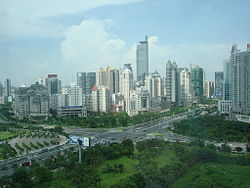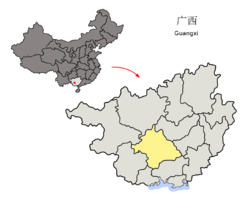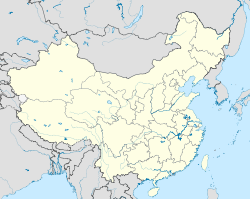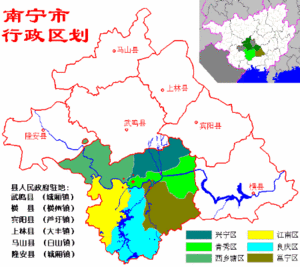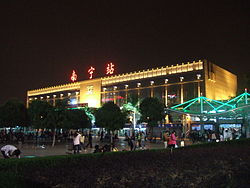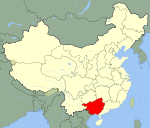- Nanning
-
Nanning
南宁
Namzningz— Prefecture-level city — 南宁市 · Namzningz Si Nanning Skyline Location of the Nanning Prefecture in Guangxi Location within China Coordinates: 22°49′N 108°19′E / 22.817°N 108.317°ECoordinates: 22°49′N 108°19′E / 22.817°N 108.317°E Country People's Republic of China Region Guangxi County-level
divisionsTownship
divisionsArea – Prefecture-level city 22,189 km2 (8,567.2 sq mi) – Urban 6,559 km2 (2,532.4 sq mi) – Metro 5,264 km2 (2,032.4 sq mi) Population (2010 census) – Prefecture-level city 6,661,600 – Density 300.2/km2 (777.6/sq mi) – Urban 2,875,220 – Urban density 438.4/km2 (1,135.4/sq mi) – Metro 2,480,340 – Metro density 471.2/km2 (1,220.4/sq mi) Time zone China Standard Time (UTC+8) Postal code 530000 Area code(s) 771 License plate prefixes 桂A Website Nanning.gov.cn Nanning Chinese name Simplified Chinese 南宁 Traditional Chinese 南寧 Literal meaning south prosperity Transcriptions Mandarin - Hanyu Pinyin Nánníng Min - Hokkien POJ Lâm-lêng Cantonese (Yue) - Jyutping naam4ning4 Zhuang name Zhuang Namzningz Nanning (simplified Chinese: 南宁; traditional Chinese: 南寧; pinyin: Nánníng, Zhuang: Namzningz, meaning 'South Tranquility') is the capital of the Guangxi Zhuang Autonomous Region in southern China. It is known as the "Green City" because of its abundance of lush tropical foliage.
Contents
History
A county seat called Jinxing was first established at the site in AD 318. This became the administrative seat of a commandery. Nanning was once the territory of the Baiyue people and became the capital of Jinxing Prefecture which was separated from Yulin Prefecture of the Eastern Jin Dynasty.
In 589 the Jinxing commandery was dissolved, and the county was renamed Xuanhua. Under the Tang dynasty (618–907) the prefecture of Yong (邕州Yongzhou) was established there; it was garrisoned to control the non-Chinese districts in Guangxi and on the Yunnan–Guizhou provincial border. In the mid-9th century the Tang and the Yunnan state of Nanzhao fought over it, and after 861 it was briefly occupied by Nanzhao. It remained a frontier prefecture throughout the Song dynasty (960–1279), being the scene of a rebellion led by Nong Zhigao in 1052 and thereafter a garrison town.
In the Yuan Dynasty in 1324, it was renamed Nanning Lu (an administrative division) of Yongzhou Lu meaning "May peace maintain in the southern frontier", hence the name Nanning. Historically, Nanning was famous for trade, and had permanent business offices from other areas in China since the Song Dynasty.
Under the Ming (1368–1644) and Qing (1644–1911) dynasties, it was a superior prefecture. In the Ming Dynasty Nanning developed into the commodity distributing center of the Zuojiang River and the Youjiang River with the reputation of "Little Nanjing".
Opened to foreign trade by the Chinese in 1907, Nanning grew rapidly. From 1912 to 1936 it was the provincial capital of Guangxi, replacing Guilin.
Early in the 20th century the city spilled over from the old walled city into a southern suburban area. In the 1930s Nanning became the centre of a "model provincial government" under the warlord Li Zongren, and a spacious modern city was laid out. During the Second Sino-Japanese War (1937–45), Nanning was temporarily occupied in 1940 by the Japanese. It subsequently became an important U.S. air base supporting the Chinese armies in Guangxi, but during 1944–45 it was again under Japanese occupation.
In 1949 Nanning again became the provincial capital, first of Guangxi province and then (1958) of the renamed Guangxi Zhuang Autonomous Region. Until then Nanning had essentially been a commercial center dependent on Guangzhou and on the Xi River system. In the late 1930s a railway was begun, joining Hengyang in southern Hunan province with Guilin, Liuzhou, Nanning, and the Vietnam border, while another was begun from Liuzhou to Guiyang in Guizhou. The construction of the Nanning section of this line was halted in 1940 by the Japanese advances, however, and was not completed until 1951, after which Nanning was directly linked with central China; completion of a branch line to the port of Zhanjiang (in Guangdong) in 1957 gave it a direct outlet to the sea. During the French war in Indochina (1946–54), Nanning was the chief support base in China for the Vietnamese forces, and during the Vietnam War in the 1960s and early 1970s it again became a staging post for the sending of supplies southward to North Vietnam. It was also an important military supply center during the Sino-Vietnam confrontation in 1979.
Formerly an essentially commercial and administrative center, Nanning from 1949 experienced industrial growth. The city is surrounded by a fertile agricultural region producing subtropical fruits and sugarcane; food processing, flour milling, sugar refining, meatpacking, and leather manufacture are important in the city. Nanning has been a center for printing and paper manufacture, and it is also important in heavy industry.
After the recognition of the Zhuang ethnic minority in 1958, Nanning became the chief center for the training of Zhuang leaders. Guangxi University, a large medical school, and a school of agriculture all date from the 1920s.
A cavern at Yiling, 19 km to the northwest, has a 1,100 m passage through picturesque stalactites. In the 1970s colored lights were installed and the cavern was developed as a tourist attraction.
Nanning serves as host for the annual China-ASEAN EXPO (CASEAN EXPO) which began in 2005 and was the venue for the 2006 "World Robotics Olympiad".
Geography
Nanning Climate chart (explanation) J F M A M J J A S O N D 35171043181259221597272018630232073225219332520533251283224662820402415252011Average max. and min. temperatures in °C Precipitation totals in mm Source: CMA Imperial conversion J F M A M J J A S O N D 1.462501.764532.371593.880677.387738.190778.691788.19177589742.683681.6756016852Average max. and min. temperatures in °F Precipitation totals in inches Nanning is located in the southern part of Guangxi Zhuang Autonomous Region, 160 km from the border with Vietnam. It has an area of 22,293 square kilometers.[1]
The city is located on the north bank of the Yong River, the chief southern tributary of the Xi River, and lies some 30 km below the confluence of the Yu and the Zuo rivers. The Yong River (which later becomes the Yu River) affords a good route to Guangzhou and is navigable by shallow-draft junks and motor launches, even though it is obstructed by rapids and sandbanks.
Nanning is situated in a hilly basin with elevations between 70 and 500 m above sea-level. Qingxiu Mountain dominates the southern part of town.
Climate
Nanning has a warm, monsoon-influenced humid subtropical climate (Köppen Cfa). Summers are hot and humid with average highs almost reaching 33 °C in July and August. Winters are mild and somewhat damp with 10 °C average lows in January. It is often windy or breezy and very rainy in the city, with about 1,310 millimetres (51.6 in) of rainfall annually. Nanning is also frost-free for all but 3 or 4 days a year and snowfall is virtually unheard of in the city.
Climate data for Nanning (1971-2000) Month Jan Feb Mar Apr May Jun Jul Aug Sep Oct Nov Dec Year Average high °C (°F) 16.9
(62.4)18.0
(64.4)21.5
(70.7)26.6
(79.9)30.4
(86.7)32.1
(89.8)32.9
(91.2)32.7
(90.9)31.6
(88.9)28.4
(83.1)24.1
(75.4)20.2
(68.4)26.3 Average low °C (°F) 10.0
(50.0)11.5
(52.7)15.0
(59.0)19.6
(67.3)22.8
(73.0)24.9
(76.8)25.4
(77.7)25.2
(77.4)23.6
(74.5)20.2
(68.4)15.3
(59.5)11.3
(52.3)18.7 Rainfall mm (inches) 35.3
(1.39)42.6
(1.677)59.4
(2.339)97.1
(3.823)185.6
(7.307)207.1
(8.154)218.8
(8.614)205.3
(8.083)128.3
(5.051)65.5
(2.579)40.3
(1.587)24.5
(0.965)1,309.8
(51.567)% humidity 78 81 82 81 80 82 82 82 78 75 74 74 79.1 Avg. rainy days (≥ 0.1 mm) 11.1 13.2 13.8 13.6 16.6 16.3 16.8 16.2 10.5 8.5 6.8 5.9 149.3 Sunshine hours 69.6 56.7 61.8 91.4 144.0 161.1 196.8 186.1 185.6 163.7 144.2 123.7 1,584.7 Source: 中国气象局 国家气象信息中心 Flora and fauna
Nanning's warm climate gives it a large amount of biodiversity. There are many species of animals and more than 3,000 species of plants. The city flower is the Jaba flower, an evergreen shrub, and the city tree is the almond tree which is regarded as the backbone tree used for greening and landscaping throughout the city.
Administrative divisions
Nanning has jurisdiction over 6 districts, 6 counties, and 6 development zones.
Districts:
- Xingning District (兴宁区)
- Qingxiu District (青秀区)
- Jiangnan District (江南区)
- Xixiangtang District (西乡塘区)
- Liangqing District (良庆区)
- Yongning District (邕宁区)
Counties:
- Wuming County (武鸣)
- Long'an County (隆安)
- Mashan County (马山)
- Shanglin County (上林)
- Binyang County (宾阳)
- Heng County (横县)
Development Zones:
- Nanning High-Tech Business DZ (南宁高新技术产业开发区)
- Nanning Economic and technology DZ (南宁经济技术开发区)
- Nanning Overseas Chinese Investment Zone (南宁华侨投资区)
- Nanning Qingxiu Mountain Resort/ Tourism Area (南宁青秀山风景名胜旅游区)
- Nanning Xiangsi Lake New Area (南宁相思湖新区)
- Nanning Liujing Industrial Park (南宁六景工业园区)
Cityscape
Nanning is home of the 21st tallest building[2] in the People's Republic of China, the Diwang International Commerce Center (276 m), currently the tallest building in Guangxi and southwestern China (excluding Chongqing). The second tallest building in Nanning is the World Trade Commerce City at 218 meters. The city currently has seven buildings taller than 100 meters, built or under construction.
Nanning has many parks with tropical lush green landscape, it is one of the "greenest" cities in China, and it's known as "Green City"(绿城). Nanning's downtown skyline is rapidly changing and the city is becoming an important hub in China.
Economy
Nanning's GDP in 2007 was 106.3 billion RMB, which was a 17.1% growth over the previous year. The GDP per capita was ¥15,685 (US$2,147), ranking no. 116 among 659 Chinese cities. Foreign exports in 2007 were 10 billion USD. Foreign fixed asset investment was 34.3 billion RMB. Nanning has six development zones and industrial parks, three of which accounted for 6 billion RMB of Nanning's GDP, more than 8% of Nanning's total.
Mineral resources include gold, iron, manganese, aluminum, quartz, silver, indium, coal, marble, and granite. One third of China's different types of mineral resources are found in Nanning.
Industrial zones
- Guilin High-tech Industrial Development Zone
- Nanning Economic & Technological Development Area
Transportation
Air
Rail
In November 2008 construction of a high-speed rail line from Nanning to Guangzhou began, which will cut travel time between the two cities from 13 hrs to 3 hrs. The line is set to be 577 km long, of which 61% will be in Guangxi, and will allow trains to run up to 200 km/h. It will be completed in four years and cost about 41 billion yuan(about 6 billion U.S. dollars), according to the Ministry of Railways. The goal is to better integrate Pan-Pearl River Delta and southeast China with members of the ASEAN.[3]
There are also plans to build a high-speed railway to Pingxiang on the Vietnamese border.[4]
Highways
Demographics
At 2010 census , the total population of Nanning was 6,611,600, among which 2,875,220 million were urban residents (after the adjustment of administrative divisions) and 2,480,340 million in the built up area made of 5 out of 6 urban districts. Nanning is a city in which Zhuang ethnic group live in compact communities, and also the only city in all the autonomous regions of China with open coastal areas. Thirty-five ethnic groups live in compact communities in Nanning, including people of Zhuang, Han, Yao, Hui, Miao, Dong, and Man minorities.
Culture
Nanning is the center of science and technology, education, culture and health in Guangxi Province. There are altogether 54 scientific research institutes subordinate to districts. 10 colleges and 50 trade schools are training specialised personnel of all kinds. Now there are 62 mass cultural organizations, 13 performing groups, 8 cinemas, 285 projecting units, over 70 karaoke halls and over 1000 newsstands. Bookshops and cultural markets can be found everywhere.
Food
Nanning has not only local cuisine but also food from other areas of China and abroad. Traditional food culture can be found around most streets of Nanning. Nanning food shares the style of Cantonese food and of Southeast Asia. Chinese cuisine including Guangdong, Szechuan, Hunan and Jiangsu as well as Japanese, Thai and Western cuisines can be found.
Rice noodles are very popular among the Nanning people. Laoyou rice noodles are the most famous, while other noodle dishes such as Guilin rice noodles and hand made noodles can be found.
Tourism
Nanning is close to scenic Guilin, with its world famous hillscape, northern and western Guangxi and its minority villages, and the border with Vietnam in the south.
In 1998 alone, the city received 26,260 overseas tourists, earning foreign exchange totaling US$7.0663 million, some 5.01 percent of the city's total income. An addition of 6.89 million domestic visitors brought RMB 3.23 billion yuan into the city, some 19.95 percent of the total.
The major tourist attractions in Nanning are as following:
- Qingxiu Mountains Landscape (a park at provincial level)
- Guangxi Museum
- Guangxi Medicinal Botanical Garden
- Liangfengjiang River Scenic Spot (a state forest reserve)
- Phoenix Lake Holiday Site
- Minorities Cultural Relics Center
- Western Suburbs Zoo (including the country's largest Crocodile, Elephant,and Hippopotamus Enclosure)
- Golden Scented-Tea Park (the country's largest base for golden scented tea seeds)
- The Ruins of the Battlefield of Kunlunguan
- Yangmei Ancient Town
- Lingshui Hot Spring (a large constant hot spring)
- Mingxiu Park
- Daming Muntain
- The Beiqiu ruins of Dingshishan Mountain (one of 1997's 10 Greatest Archaeological Discoveries in China.)
Hotels
Colleges and universities
- Guangxi University (广西大学) (founded 1928) features Xingjian College (added in 2005)
- Guangxi University for Nationalities (广西民族大学)
- Guangxi Medical University (广西医科大学)
- Guangxi Traditional Chinese Medical University (广西中医学院)
- Guangxi Teachers College (广西师范学院) (founded 1953)
- Guangxi Arts College (广西艺术学院)
- Guangxi University of Finance and Economics (广西财经学院)
- Guangxi Educational College (广西教育学院)
Note: Institutions without full-time bachelor programs are not listed.
International relations
Main article: List of twin towns and sister cities in ChinaTwin towns — sister cities
Nanning is twinned with:
 Bundaberg, Queensland, Australia (1998)
Bundaberg, Queensland, Australia (1998) Provo, Utah, United States (2000)
Provo, Utah, United States (2000) Klagenfurt am Wörthersee, Austria (2001)
Klagenfurt am Wörthersee, Austria (2001) Amphoe Mueang Khon Kaen, Khon Kaen Province, Thailand (2001)
Amphoe Mueang Khon Kaen, Khon Kaen Province, Thailand (2001) Davao City, Philippines (2006)
Davao City, Philippines (2006) Ipoh, Malaysia (2001)
Ipoh, Malaysia (2001) Yangon, Myanmar (2009) [5]
Yangon, Myanmar (2009) [5]
References
- ^ "Profile of Nanning" (in Chinese). Archived from the original on 10 June 2008. http://web.archive.org/web/20080610061220/http://www.xzqh.org/QUHUA/45gx/01nanning.htm. Retrieved 2008-06-11.
- ^ According to the table on List of tallest buildings in the People's Republic of China
- ^ "China starts construction of Nanning-Guangzhou high-speed rail line". Xinhua. 9 November 2008. http://news.xinhuanet.com/english/2008-11/09/content_10332002.htm. Retrieved 28 August 2010.
- ^ "High-speed railway to boost trade". http://www.chinadaily.com.cn/bizchina/2011-01/18/content_11874287.htm. Retrieved 2011-02-19.
- ^ http://english.nanning.gov.cn/n725531/n751804/n752331/n819950/5880844.html
External links
- Nanning Government website (Chinese)
- Nanning Government website (English)
- Nanning Here: citizen life introduction (English)
- Nanning Tourism Information Network
- Agricultural Information Network in Nanning City
- Nanning City Library
- Nanning Local TV Station
Guangxi topics Nanning (capital)General Geography Education Culture Cuisine Luosifen • TuotuorouVisitor attractions Guangxi Zhuang Autonomous Region county-level divisions Nanning (capital)Nanning: Qingxiu District · Xingning District · Xixiangtang District · Liangqing District · Jiangnan District · Yongning District · Wuming County · Long'an County · Mashan County · Shanglin County · Binyang County · Heng County
Liuzhou: Chengzhong District · Yufeng District · Liubei District · Liunan District · Liujiang County · Liucheng County · Luzhai County · Rong'an County · Rongshui Autonomous County · Sanjiang Autonomous County
Guilin: Xiangshan District · Xiufeng District · Diecai District · Qixing District · Yanshan District · Yangshuo County · Lingui County · Lingchuan County · Quanzhou County · Pingle County · Xing'an County · Guanyang County · Lipu County · Ziyuan County · Yongfu County · Longsheng Autonomous County · Gongcheng Autonomous County
Wuzhou: Wanxiu District · Dieshan District · Changzhou District · Cenxi City · Cangwu County · Teng County · Mengshan County
Beihai: Haicheng District · Yinhai District · Tieshangang District · Hepu County
Fangchenggang: Gangkou District · Fangcheng District · Dongxing City · Shangsi County
Qinzhou: Qinnan District · Qinbei District · Lingshan County · Pubei County
Guigang: Gangbei District · Gangnan District · Qintang District · Guiping · Pingnan County
Yulin: Yuzhou District · Beiliu City · Rong County · Luchuan County · Bobai County · Xingye County
Baise: Youjiang District · Lingyun County · Pingguo County · Xilin County · Leye County · Debao County · Tianlin County · Tianyang County · Jingxi County · Tiandong County · Napo County · Longlin Autonomous County
Hezhou: Babu District · Zhongshan County · Zhaoping County · Fuchuan Autonomous County
Hechi: Jinchengjiang District · Yizhou City · Tian'e County · Fengshan County · Nandan County · Donglan County · Du'an Autonomous County · Luocheng Autonomous County · Bama Autonomous County · Huanjiang Autonomous County · Dahua Autonomous County
Laibin: Xingbin District · Heshan City · Xiangzhou County · Wuxuan County · Xincheng County · Jinxiu Autonomous County
Chongzuo: Jiangzhou District · Pingxiang City · Ningming County · Fusui County · Longzhou County · Daxin County · Tiandeng CountyMost populous metropolises in the People's Republic of China Metropolitan cities of the People's Republic of China Municipalities and National central cities Regional central cities Special administrative regions Sub-provincial cities (not included above) Separate state-planning cities (not included above) Provincial capitals (not included above) Autonomous regional capitals Comparatively large cities (not included above) Special economic zone cities (not included above) Coastal development cities (not included above) XPCC / Bingtuan cities State-level new areas Pudong New Area (Shanghai) · Binhai New Area (Tianjin) · Liangjiang New Area (Chongqing) · Zhoushan Archipelago New Area (Zhoushan)Provincial capitals of the People's Republic of China Changchun, Jilin · Changsha, Hunan · Chengdu, Sichuan · Fuzhou, Fujian · Guangzhou, Guangdong · Guiyang, Guizhou · Haikou, Hainan · Hangzhou, Zhejiang · Harbin, Heilongjiang · Hefei, Anhui · Hohhot, Inner Mongolia · Jinan, Shandong · Kunming, Yunnan · Lanzhou, Gansu · Lhasa, Tibet · Nanchang, Jiangxi · Nanjing, Jiangsu · Nanning, Guangxi · Shenyang, Liaoning · Shijiazhuang, Hebei · Taiyuan, Shanxi · Ürümqi, Xinjiang · Wuhan, Hubei · Xi'an, Shaanxi · Xining, Qinghai · Yinchuan, Ningxia · Zhengzhou, Henan
Dongcheng District (Beijing) · Yuzhong District (Chongqing) · Huangpu District (Shanghai) · Heping District (Tianjin)
 Categories:
Categories:- 310s establishments
- Cities in Guangxi
- Prefecture-level divisions of Guangxi
- Provincial capitals in China
Wikimedia Foundation. 2010.

